by Lisa Cooke | Oct 30, 2017 | 01 What's New, Archive Lady, Volunteer
The National Archives Citizen Archivist program is recruiting help to tag, transcribe, and comment on records in the U.S. National Archives catalog. This is a great way for genealogy volunteers to help others discover their family history in the National Archives and learn for themselves what’s there.
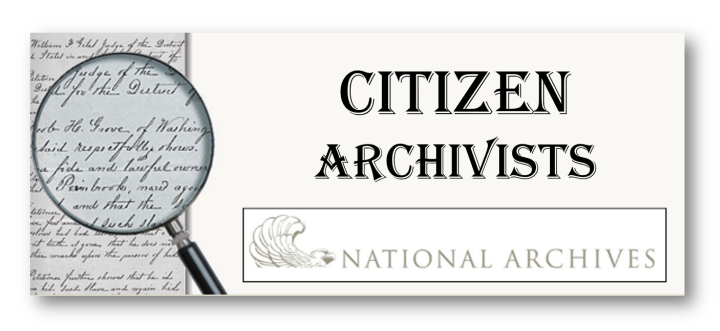
The National Archives Citizen Archivist Program
Have you heard? The U.S. National Archives is looking for Citizen Archivists! What is a Citizen Archivist, you ask? A Citizen Archivist is a virtual volunteer that helps the U.S. National Archives increase the online access to their historical records. This is done by crowdsourcing metadata about their records through tagging, transcribing, and adding comments to the U.S. National Archives catalog.
As a Citizen Archivist, you will be volunteering your time to make historical and genealogical records more accessible to the general researching public to help them with their research. This could include genealogists, historians, writers, and other researchers that will benefit from your volunteer work. And who knows, maybe you will find records that belong to your ancestors!
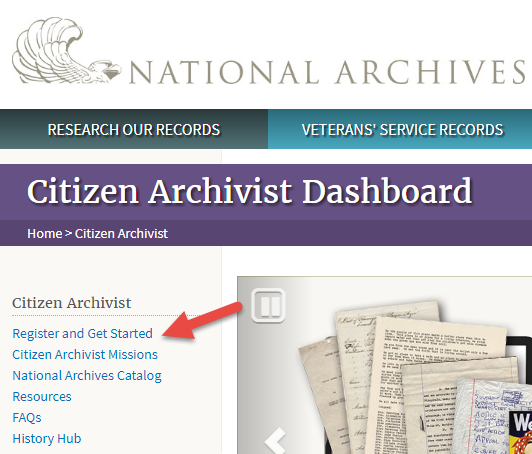 How to Get Started as a National Archives Citizen Archivist
How to Get Started as a National Archives Citizen Archivist
First, you will need to go to the “Citizen Archivist Dashboard” at the U.S. National Archives website. Once there, you will need to register to be a Citizen Archivist (see the screenshot on the right for where to click). Registration is free but you do need this account to be able to contribute to the project. Once you are registered and logged in, you can then navigate to the catalog and choose records from the curated missions.
The “missions” are groups of records that need transcribing or tagging to help the records be more accessible to researchers working online. Some of the missions that are needing transcribing are “Fugitive Slave Case Files,” “Native American Reservations,” and “The Truman-Churchill Telegrams,” just to name a few. New missions are added to the site regularly, so be sure to check back often to see what is new that you would like to work on.
Who Can Contribute as a Citizen Archivist?
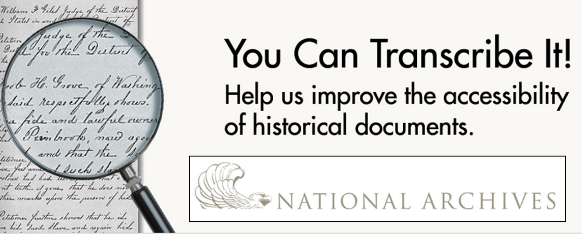 Anyone who has a computer and the willingness to volunteer time to this project can contribute. You do not need to commit to any amount of time; you can work at your own pace as you have the extra time. There is even a support community available through the “History Hub” that can answer your questions as you work through the records. (You can click on that at the bottom of the list shown in the screenshot above.)
Anyone who has a computer and the willingness to volunteer time to this project can contribute. You do not need to commit to any amount of time; you can work at your own pace as you have the extra time. There is even a support community available through the “History Hub” that can answer your questions as you work through the records. (You can click on that at the bottom of the list shown in the screenshot above.)
So, if you have some time on your hands and want to help make historical and genealogical records more accessible online, why not become a Citizen Archivist today? Click here to get started–or click below to read more ideas about how to give back to the genealogy community.
 The Unclaimed Persons Project
The Unclaimed Persons Project
Help Curate Holocaust-Era Newspaper Articles
Transcribe GPS Gravestone Images at BillionGraves
by Lisa Cooke | Jul 16, 2015 | 01 What's New, History, images, Inspiration, Libraries, Memory Lane, Volunteer
 By now, many of us have tried our hand at volunteer indexing and transcribing projects. We can index censuses, civil and church vital records, gravestone images, and more with FamilySearch, BillionGraves, Ancestry’s World Archives Project and even with individual archives like The Congregational Library.
By now, many of us have tried our hand at volunteer indexing and transcribing projects. We can index censuses, civil and church vital records, gravestone images, and more with FamilySearch, BillionGraves, Ancestry’s World Archives Project and even with individual archives like The Congregational Library.
What about de-classified CIA records and other government documents? Love letters between President Lyndon and Lady Bird Johnson? These are among the indexing projects currently on the National Archives (US) Citizen Archivist dashboard.
“We have millions of pages of digitized records available in our online catalog,” says the Citizen Archivist website. “Transcription is an important way for us to improve search results and increase accessibility to our historical records. Your contributions make a big impact.” Other current projects include Confederate government papers, interviews relating to the September 11 terrorist attacks and letters to President Eisenhower about integrating schools.
These are all historically vital important records for the U.S. that may also shed light on our ancestors’ lives. My grandfather worked on classified government projects and I’m hoping to find his name in formerly “top secret” papers someday! Why not give it a try–index a batch of records through the National Archives Citizen Archivist project?
 Learn more about inspiring genealogy volunteers on our blog! On the lower left side of the Genealogy Gems home page, click the category “Volunteer.” See what others do to help–and perhaps you’ll get inspired yourself!
Learn more about inspiring genealogy volunteers on our blog! On the lower left side of the Genealogy Gems home page, click the category “Volunteer.” See what others do to help–and perhaps you’ll get inspired yourself!
by Lisa Cooke | Mar 24, 2014 | 01 What's New, History, NARA, Photographs
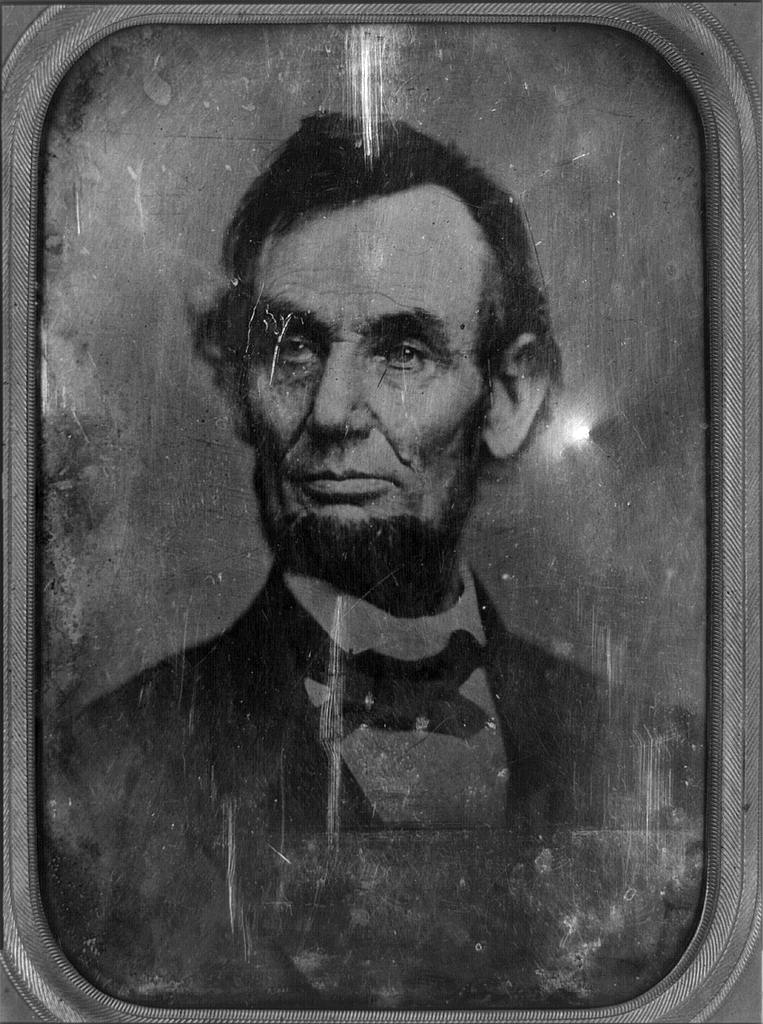
Daguerrotype of a Photograph of Abraham Lincoln, used for the $5 Bill. Original taken on February 9, 1864. Photographer unidentified [Public domain], via Wikimedia Commons.
Mystery photos are one of a family history researcher’s biggest frustrations. We find them in old albums, between the pages of books or in loose files. It can heartbreaking to wonder whether we’re looking at the face of an ancestor–and to know we may never know for sure.
Well, we’re not alone. Two news stories ran recently about old mystery photos theorized to be two icons of American history: President Abraham Lincoln and singer Elvis Presley!
(Image Right: Daguerrotype of a Photograph of Abraham Lincoln, used for the $5 Bill. Original taken on February 9, 1864. Photographer unidentified [Public domain], via Wikimedia Commons.)
Mystery Photos: Abraham Lincoln Funeral
The Washington Post recently posted a story about the possibility that some unidentified photos at the National Archives (U.S.) show rare images of Abraham Lincoln’s funeral procession in New York City.
The article gives some great back story how Lincoln’s 2-week+ funeral procession. His body traveled by rail and horse-drawn hearse for 1600 miles from Washington, D.C. back home to Springfield, Illinois. Along the way, there were stops for elaborate funeral processions in several cities. Millions of mourners turned out. The article quotes the man who put together this theory – a retired government accountant who loves historic photos.
Mystery Photo: A Young Elvis Presley?
The Blaze recently reported on an Elvis sighting: well, at least a photo sighting of Elvis. The image in question shows a young teenage boy. There are lots of questions about whether this is really The King before fame changed his life – and American pop music – forever.
These remind me of a genealogy blog post by Lisa Frank. She shares how listening to the Genealogy Gems Podcast led to the discovery of an online video that may belong to her family story. Read her post Could It Be My Ancestor? and chime in with your opinion.
What surprising, poignant or fascinating mystery photos have you found in your family history research? Share them on the Genealogy Gems Facebook page and tell us about them! I look forward to seeing them!
by Lisa Cooke | Mar 17, 2014 | 01 What's New, Libraries, NARA
National Archives (US) facilities are closing or restructuring in three locations. But steps are being taken to maintain access (local or online) to the
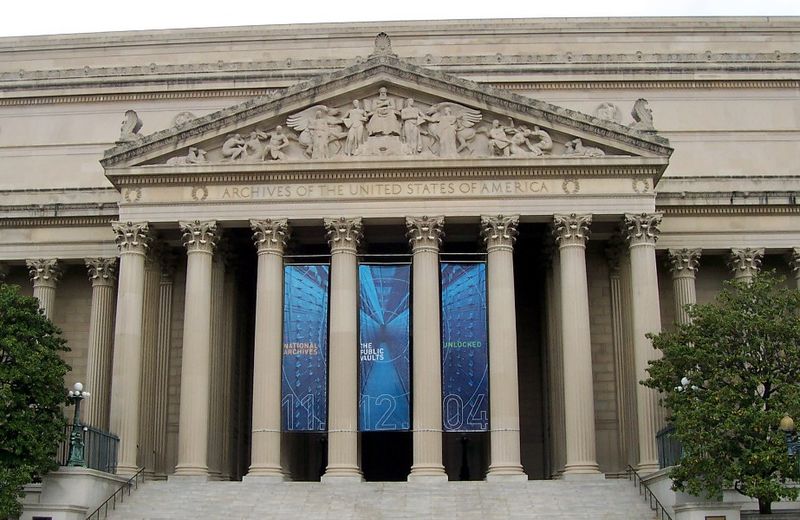
National Archives, Washington, D.C. Wikimedia Commons Image by Edbrown05.
treasure trove of research materials at these facilities.
A recent press release states, “As part of ongoing budget adjustments, Archivist of the United States David S. Ferriero announced the permanent closure of three National Archives facilities. This year, the National Archives facility in Anchorage, AK, will close and two facilities in the Philadelphia, PA, area will be consolidated to a single site. Within the next two years, two Archives’ facilities in Fort Worth, TX, also will be consolidated to a single site. These closures and consolidations will result in estimated annual cost savings of approximately .3 million.”
“The National Archives budget is devoted primarily to personnel and facilities, both of which are essential to our mission,” the Archivist stated. “I recognize these cuts will be painful; however, we are committed to continuing to provide the best service to our customers and best working conditions for our staff nationwide.”
Here’s the scoop on each of the affected locations:
National Archives – Anchorage, AK, facility closing:
The National Archives’ facility in Anchorage, AK, will close permanently in FY 2014. The employees who work there will be offered positions at other National Archives facilities, with the National Archives paying relocation expenses. The less than 12,000 cubic feet of archival records in Alaska will be moved to the National Archives at Seattle, WA, where the National Archives will digitize these records so that they remain available to Alaskans through the internet. In addition, we will move approximately 7,500 cubic feet of records center holdings to Seattle, WA.
National Archives – Philadelphia, PA, facility consolidation:
The National Archives currently maintains two facilities in Philadelphia—a records center and archives at Townsend Road, and a small “storefront” archival facility at 900 Market Street in the city center. These facilities are in the same commuting area, and archival records are currently moved between the two for research use. The Market Street facility will close in FY 2014, and those employees will move to Townsend Road or telework locations. The less than 5,000 cubic feet of archival records stored at Market Street will be moved to Townsend Road, where the majority of the archival records already are stored. The Townsend Road facility’s research room will be modified to better provide appropriate access to researchers, and community outreach programs will continue.
National Archives – Fort Worth, TX, facility consolidation:
The National Archives currently maintains two facilities in Fort Worth: a combined records center and archives at John Burgess Drive, and a smaller “storefront” facility at Montgomery Plaza. The National Archives will permanently close the Montgomery Plaza facility in FY 2016. All employees at the Montgomery Plaza location will move to John Burgess or telework locations. No original records are stored at Montgomery Plaza, and researchers will have continued access to archival records through the research room at John Burgess Drive.
What’s at National Archives facilities for family history researchers? Learn more here.
by Lisa Cooke | Nov 26, 2013 | 01 What's New, British, Canadian, Family History Podcast, FamilySearch, NARA, Records & databases
 Originally published Fall 2008
Originally published Fall 2008
Republished November 26, 2013
by Lisa Louise Cooke
[display_podcast]
Download the Show Notes for this Episode
Family History: Genealogy Made Easy
Welcome to this step-by-step series for beginning genealogists—and more experienced ones who want to brush up or learn something new. I first ran this series in 2008. So many people have asked about it, I’m bringing it back in weekly segments.
Episode 8: Best Genealogy Websites, Part 2
In a follow up to last week’s episode about subscription genealogy records website, in my first segment our guest is Yvette Arts, Director of Content Partnerships at World Vital Records. She tells us about exciting developments at the website that have helped make it a success.
In our second segment we look at five organizations that provide free online access to genealogy records for those with North American roots: FamilySearch, the National Archives of the United States, Ellis Island Foundation, the National Archives of the United Kingdom, and Library and Archives Canada.
Now for some updates on these sites and MORE since the show first aired:
- FamilySearch.org is still free and growing exponentially. It captures records from all over the world, not just North America and the U.K. It is now home to over 3.5 billion names in searchable databases, with over 35 million new records added every month. In addition, they’ve added over 60,000 digital books to the site. The layout of the website has changed dramatically since I described it in the original show. Click on Search to get to their databases, then enter an ancestor’s name and, if you can, a life event (birth, marriage, residence or death). A significant portion of new online records are browsable but not yet indexed. So now, after you search for individuals in their databases, scroll down to the Browse section below the search fields. There you’ll be able to see what records you can browse for a locale (choose the international region, then you can choose more specific locations). You can still order microfilmed records at the Family History Library to a satellite FamilySearch library near you. From the Search screen, choose Catalog, and you can search for and order available records by location.
- The National Archives (U.S.), also known as the National Archives and Record Administration (NARA) also offers more on its website now. The portal for genealogists looks a little different now but still helps you see how to search and use the site for genealogy. There’s a direct link to the 1940 census, with images, maps and descriptions. Remember that Footnote, the subscription site I mentioned that’s digitizing military records, is now Fold3, which we talked about in Episode 7.
- EllisIsland.org still offers free access to the passenger records of those who landed at Ellis Island. In addition, you can still look at ship information (click on Ships from the home page). The Immigrant Experience and timeline I mention can be found by clicking on the Ellis Island tab.
- The National Archives (U.K.) links from the home page to resources for ordering birth, marriage and death certificates for England and Wales, Scotland and Northern Ireland. Read about updating order information, including costs, at these sites. There is still a portal for genealogists from which you can learn all about the various record groups I mention in the podcast and more.
- Library and Archives Canada continues to add more valuable genealogical data to its site, including census data! Start from its Genealogy and Family History page. In addition to the features I mention in the show, they’ve improved their online indexes: scroll down on the above page and you’ll find the Ancestors Search (Databases) link to a main search engine and individual databases for vital records, censuses, immigration, land, military and several directories.
- Cyndi’s List and U.S. GenWeb are still fantastic online resources, but add to your list these ones as well:
- DeadFred, a photo identifying and sharing site;
- Google, for searching across the Internet for everything from individual ancestor’s names to maps and local histories (especially through Google Books at www.books.google.com);
- The Library of Congress family of websites, including the mega-newspaper site, Chronicling America;
- WorldCat, an enormous card catalog for more than 10,000 libraries worldwide.
- Find a Grave and Billion Graves, home to cemetery inscriptions for millions of tombstones.
- Of course, there are many, many more websites for genealogists, but these will certainly keep you busy to start!

 How to Get Started as a National Archives Citizen Archivist
How to Get Started as a National Archives Citizen Archivist Anyone who has a computer and the willingness to volunteer time to this project can contribute. You do not need to commit to any amount of time; you can work at your own pace as you have the extra time. There is even a support community available through the “History Hub” that can answer your questions as you work through the records. (You can click on that at the bottom of the list shown in the screenshot above.)
Anyone who has a computer and the willingness to volunteer time to this project can contribute. You do not need to commit to any amount of time; you can work at your own pace as you have the extra time. There is even a support community available through the “History Hub” that can answer your questions as you work through the records. (You can click on that at the bottom of the list shown in the screenshot above.)
 The Unclaimed Persons Project
The Unclaimed Persons Project







